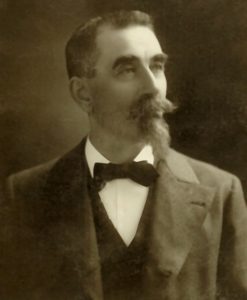Frederick Ferdinand Schafer was born in Braunschweig, Germany, on August 16, 1839. In 1876, at the age of 37, he emigrated to the United States. While in the United States, he created some 500 paintings of western American landscapes, and he died in Oakland, California, on July 18, 1927. He is well known within a community of collectors of and dealers in western art, mostly in California and the Pacific Northwest.
Schafer’s training in Germany is unknown. His work resembles that of the Düsseldorf school and contemporary newspaper writers sometimes suggested a connection. He had studios in San Francisco from 1880 through 1886 and in his homes in Alameda and Oakland from 1887 until his death.
He apparently spent summers sketching in Oregon, Washington, Idaho, Montana, Wyoming, Utah, British Columbia, and Alaska. Many of his paintings bear verso titles with locations in those states and provinces. Most Schafer landscapes are summer scenes, probably because the majestic scenes he frequently painted were difficult to visit in the winter. A member of the San Francisco Art Association for many years, he regularly exhibited his paintings at the Mechanics Institute exhibitions in that city.
Schafer’s overall style is that of the nineteenth-century American realist landscape tradition, taking maximum advantage of the dramatic western American landscape and with a strong element of naturalism — a preference to capture the impression of an object such as a tree rather than to provide photographic detail of it. Many of Schafer’s canvases have a dramatic appearance, arising from use of large areas of intense, saturated color and contrasting light, but stopping well short of the awesome and melodramatic effects found in canvases of Thomas Cole, Albert Bierstadt, and Frederic Edwin Church.
In mountain, forest, and river landscapes, foreground deadwood in the form of a leaning or fallen tree, or a river snag, appears so frequently that one can almost depend on finding it. Small midground figures, usually of Indians but occasionally of trappers, hunters, prospectors, or even bear or deer, often appear as part of the natural landscape, providing an iconic, rather than explicit, genre touch. By their small size these figures provide the eye with a measure of, and emphasize, the large scale of the scene. Another frequent feature in Schafer paintings is small spots of bright color, representing wildflowers, a campfire, lights from a ship, or dappled spots of sun in the shade of a tree.
Schafer usually varies the level of control of the brush greatly within a single picture. Background mountains, especially foothills and intermediate ranges, may be shapes developed with only a few wide brushstrokes. Middle and foreground components are substantially more controlled, and features that draw the attention of the eye, such as a campfire, tepee, or person’s face, are often more controlled than their surroundings.
Schafer’s work is held in these public collections: Alameda (California) Free Library, Art Museum of Greater Victoria (British Columbia), Bancroft Library (Honeyman collection), British Columbia Archives, California Historical Society, Craigdarroch Castle (British Columbia), Crocker Art Museum, Hoover Institution, Monterey Peninsula Museum of Art, Monterey State Historic Park, Museum of Church History and Art (Salt Lake City), The Oakland Museum of California, Seattle Art Museum, Shasta (California) State Historic Park, Society of California Pioneers, Sonoma County (California) Museum (Hart collection), and the Yosemite National Park Museum.
In 1975, Garzoli Gallery listed one known painting by Schafer in the White Mountains — After a Storm in the White Mountains, c. 1880, oil on canvas, 22″ x 36″.
Reference
Biographical information © 1996, 1998 by Jerome H. Saltzer. All rights reserved. Direct comments, corrections, or questions to ‘saltzer@mit.edu.’
